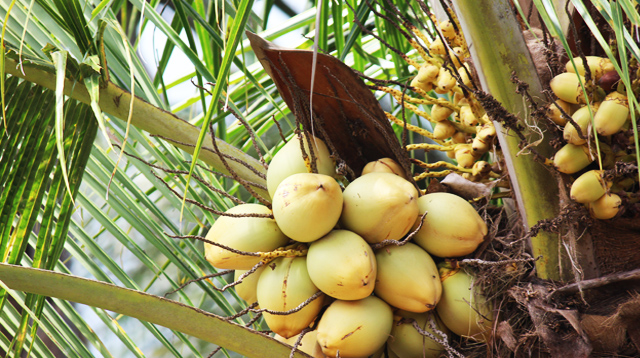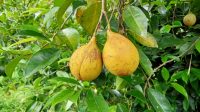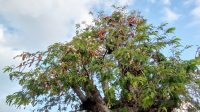- COCONUT is a versatile plant to Balinese people because most of it can be used in their life
- Hindu community in Bali benefits a lot to support their religious activities
The Balinese view the coconut tree as a versatile plant. Why does it happen? Because they can use almost the entire plant starting from the hump to the dry leaves to support their daily life.
The leaves and fruit of coconut also greatly support the implementation of the life of local Hindu community. That’s why those who still have fields, will definitely try to plant coconuts and other supporting plants such as bamboo and bananas.
The leaves
The young leaves are called busung—used to make various offerings such as canang sari, ketupat or rice bag and penjor ornaments. Penjor is one of the elements of the ritual ornament combined with the installation of bamboo offering platform to place for offerings. It is usually installed in front of house compound’s gate and temple’s gate.
The slightly green leaves are called busung demela—used to make ketupat and certain offerings which are usually stored for a long time.
Ripe leaves (dark green) or selepan—used for the base of the offerings and specially prepared to make offering stock. Meanwhile, its sticks are used to make stick broom and, skewers.
The coconut
When it is just flowering, this flower can be used as an ingredient for making vegetables or salads. However, it is rare for people to purposely look for the flowers if their coconut tree has not fallen or the tree has been cut down on purpose.
If the flower stem is cut, it will be able to produce sap which can be further processed into coconut sugar.
Bungkak or Klungah is a young coconut that doesn’t have flesh yet. Usually for the sake of rituals, people prefer to have a hybrid coconut whether it is ivory coconut, green coconut or orange coconut. Usually, this type of coconut is used for ritual contents. The water can be drunk as an antidote to feverish.
There are some Balinese people who like to make dishes made from young coconut shells without meat. The types of dishes include lawar and tum.
Meanwhile, young coconuts that already have meat can be used to make various drinks mixed with water.
Then, the ripe coconut is used to be processed to produce coconut oil. It is also used to make condiment, seasoning, a mixture for making Balinese tum (chopped meat) dishes, twisted sate, coconut lawar and vegetable seasonings.
The shell from which the fruit flesh has been extracted can be used to make charcoal which will later on be used for grilling satay or cooking other foods. Meanwhile, the fibers are used for ceremonial purposes (api takep) and to make smoked meat such as smoked chicken.
If the coconut is empty (no water and no flesh) due to an abnormal growth process, it’s best to be used for firewood or just throw it away. Likewise, pongpongan or coconut hollowed out by squirrels, whether it is with flesh or not.
Stem
Coconut tree trunks, especially old ones with dark colored fibers, are used for building materials and furniture as well as cooking utensils such as spoons, bowls, plates and others which are processed with the help of a lathe.
Meanwhile, coconut tree stumps are widely used to make unique chairs. Then the dry coconut leaves along with the dried stems and flower petals can be used for firewood.
In rural areas, such materials are available in abundance, but only a small number of people still use them because they have switched to using gas stoves.











